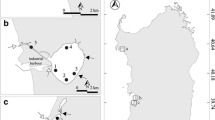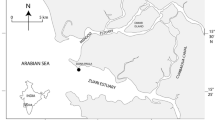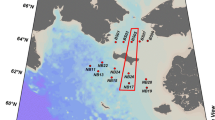Abstract
Autumn picoplankton (Synechococcus, picoeukaryotes and heterotrophic bacteria) and environmental factors have been investigated in a series of reservoirs along the Wujiang River in Guizhou Province, SW China. The average abundances of Synechococcus, picoeukaryotes and heterotrophic bacteria was 104, 102 and 106 cells ml−1, respectively. In autumn meso-eutrophic reservoirs, thermal stratification was clear and abundances of different picoplankton groups in release water was low; whereas these phenomena were not obvious in autumn hypereutrophic reservoir. Picoplankton numbers decreased with increasing water depth and showed a positive correlation with water temperature, which reflected the importance of light and temperature on the picoplankton growth. Contribution of Synechococcus to total phytoplankton production and contribution of picoeukaryotes to total phytoplankton production asynchronous changed with varying trophic states. Synechococcus preferred meso-eutrophic reservoirs over hypereutrophic reservoir and picoeukaryotes showed no preference for the investigated reservoirs in autumn.







Similar content being viewed by others
References
Agawin, N. S. R., C. M. Duarte & S. Agusti, 2000. Nutrient and temperature control of the contribution of picoplankton to phytoplankton biomass and production. Limnology and Oceanography 45: 591–600.
Andersson, A., P. Haecky & A. Hagstrom, 1994. Effect of temperature and light on the growth of micro- nano- and pico-plankton: impact on algal succession. Marine Biology 120: 511–520.
Bell, T. & J. Kalff, 2001. The contribution of picophytoplankton in marine and freshwater systems of different trophic status and depth. Limnology and Oceanography 46: 1243–1248.
Brettar, I. & M. G. Hofle, 1993. Nitrous oxide producing heterotrophic bacteria from the water column of the central Baltic: abundance and molecular identification. Marine Ecology Progress Series 94: 253–265.
Bird, D. F. & J. Kalff, 1984. Empirical relationship between bacterial abundance and chlorophyll concentration in fresh and marine waters. Canadian Journal of Fisheries and Aquatic Sciences 41: 1015–1023.
Callieri, C. & J. G. Stockner, 2002. Freshwater autotrophic picoplankton: a review. Journal of Limnology 61: 1–14.
Chen, C., X. Hu, M. Liu, J. Yi & H. Pan, 1998. A preliminary study on the distribution of phytoplankton and water pollution in Hongfeng Lake. Journal of Guizhou Normal University (Natural Science) 16: 5–10 (in Chinese).
Ernst, A., M. Deicher, P. M. J. Herman & U. I. A. Wollenzien, 2005. Nitrate and phosphate affect cultivability of cyanobacteria from environments with low nutrient levels. Applied and Environmental Microbiology 71: 3379–3383.
Gonzalez, E. J., M. Ortaz, C. Penaherrera & A. de Infante, 2004. Physical and chemical features of a tropical hypertrophic reservoir permanently stratified. Hydrobiolgia 522: 301–310.
Han, G. & C. Q. Liu, 2004. Water geochemistry controlled by carbonate dissolution: A study of the river waters draining karst-dominated terrain, Guizhou Province, China. Chemical Geology 204: 1–21.
Kimmel, B. L. & A.W. Groeger, 1984. Factors controlling primary production in lakes and reservoirs: a perspective. In Lake and Reservoir Management. Environmental Protection Agency, Washington, DC, US: 277–281.
Korneva, L. G. & N. M. Mineeva, 1996. Phytoplankton composition and pigment concentrations as indicators of water quality in the Rybinsk reservoir. Hydrobiologia 322: 255–259.
Kuang, Q., Y. Bi, Y. Xia & Z. Hu, 2004. Phytoplankton community and algal growth potential in Taipinghu Reservoir, Anhui Province, China. Lakes & Reservoirs: Research and Management 9: 119–124.
Lau, S. S. S. & S. N. Lane, 2002. Biological and chemical factors influencing shallow lake eutrophication: a long-term study. The Science of the Total Environment 288: 167–181.
Llyod, M., J. H. Zar & J. R. Karr, 1968. On the calculation of information-theoretical measures of diversity. American Midland Naturalist 79: 257–272.
Malinsky-Rushansky, N., T. Berman, T. Berner, Y. Z. Yacobi & Z. Dubinsky, 2002. Physiological characteristics of picophytoplankton, isolated from Lake Kinneret: responses to light and temperature. Journal of Plankton Research 24: 1173–1183.
Miyazaki, T., K. Tainaka, T. Togashi, T. Suzuki & J. Yoshimura, 2006. Spatial coexistence of phytoplankton species in ecological timescale. Population Ecology 48: 107–112. .
Pan, L. A., L. H. Zhang, J. Zhang, J. M. Gasol & M. Chao, 2005. On-board flow cytometric observation of picoplankton community structure in the East China Sea during the fall of different years. FEMS Microbiology Ecology 52: 243–253.
Ritchie, R. J., D. A. Trautman & A. W. D. Larkum, 2001. Phosphate uptake in the cyanobacterium Synechococcus R-2 PCC 7942. Plant Cell Physiology 38: 1232–1241.
Romo S. & M. R. Miracle, 1994. Population dynamics and ecology of subdominant phytoplankton species in a shallow hypertrophic lake (Albufera of Valencia, Spain). Hydrobiologia 213: 31–56.
Schallenberg, M. & C. W. Burns, 2001. Tests of autotrophic picoplankton as early indicators of nutrient enrichment in an ultra-oligotrophic lake. Freshwater Biology 46: 27–37.
Sieburth, J. M., V. Smetacek & J. Lenz, 1978. Pelagic ecosystem structure: heterotrophic compartments of the plankton and their relationship to plankton size fractions. Limnology and Oceanography 23: 1256–1263.
Sommaruga, R. & R. D. Robarts, 1997. The significance of autotrophic and heterotrophic picoplankton in hypertrophic ecosystems. FEMS Microbiology Ecology 24: 187–200.
Stockner, J. G., 1988. Phototrophic picoplankton: an overview from marine and freshwater ecosystems. Limnology and Oceanography 33: 765–775.
Stockner, J. G. & K. S. Shortreed, 1994. Autotrophic picoplankton community dynamics in a pre-alpine lake in British Columbia, Canada. Hydrobiologia 274: 133–142.
Stockner, J. G., C. Callieri & G. Cronberg, 2000. Picoplankton and other non-bloom forming cyanobacteria in lakes. In Whitton, B. & M. Potts (eds), Ecology of Cyanobacteria: Their Diversity in Time and Space. Kluwer Academic Publishers: 195–231.
Szelag-Wasielewska, E., 1997. Picoplankton and other size groups of phytoplankton in various shallow lakes. Hydrobiologia 342/343: 79–85.
Vrede, K., T. Vrede, A. Isaksson & A. Karlsson, 1999. Effects of nutrients (phosphorous, nitrogen, and carbon) and zooplankton on bacterioplankton and phytoplankton–a seasonal study. Limnology and Oceanography 44: 1616–1624.
Vollenweider, R. A. & J. Kerekes, 1982. Eutrophication of waters: monitoring assessment and control. Organization for Economic Co-Operation and Development (OECD), Paris, 156 pp.
Wakabayashi, T. & S. Ichise, 2004. Seasonal variation of phototrophic picoplankton in Lake Biwa (1994–1998). Hydrobiologia 528: 1–16.
Wang, B., C. Q. Liu & Y. Wu, 2003. Hydrogeochemistry and microalgae of karst lake in Guizhou province: a case study at Hongfeng Lake and Baihua Lake. In Proceedings of International Symposium on Water Resources and the Urban Environment, Wuhan, China: pp. 112–116.
Wehr, J. D., 1990. Predominance of picoplankton and nanoplankton in eutrophic Calder Lake. Hydrobiologia 203: 35–44.
Wehr, J. D., 1993. Effects of experimental manipulation of light-phosphorus supply on competition among picoplankton and nanoplankton in a oligotrophic lake. Canadian Journal of Fisheries and Aquatic Sciences 50: 936–945.
Yan, N., Y. Wang, H. Pan & C. Chen, 2006. Using phytoplankton community structure and diversity for assessment of water quality of Shatuo Reservior. Guizhou Science 24: 67–72 (in Chinese).
Acknowledgments
This study was financially supported by the Ministry of Science and Technology of China (Grant No. 2006CB403205), and also by National Natural Science Foundation of China (Grant Nos. 40603006, 90610037, and 40571158). We are grateful to Dr. C. Callieri and anonymous reviewers for valuable comments and suggestions on this manuscript.
Author information
Authors and Affiliations
Corresponding author
Additional information
Handling editor: L. Naselli-Flores
Rights and permissions
About this article
Cite this article
Wang, B., Liu, CQ., Wang, F. et al. The distributions of autumn picoplankton in relation to environmental factors in the reservoirs along the Wujiang River in Guizhou Province, SW China. Hydrobiologia 598, 35–45 (2008). https://doi.org/10.1007/s10750-007-9138-6
Received:
Revised:
Accepted:
Published:
Issue Date:
DOI: https://doi.org/10.1007/s10750-007-9138-6




